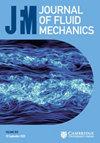作为相关聚合过程的混合
IF 3.9
2区 工程技术
Q1 MECHANICS
引用次数: 0
摘要
混合描述了在流体流动的搅拌作用下,溶质从最初的异质状态演变为均匀状态的过程。流体拉伸形成薄薄的标量薄片,这些薄片由于分子扩散而凝聚在一起。由于平流-扩散方程的线性关系,凝聚可以看作是一个聚集过程。在这里,我们证明了在平滑的二维混沌流中,混合遵从一个相关的聚集过程,聚集体中薄片数量的空间分布与它们的伸长高度相关,并且由平流材料线的分形特性决定。我们的研究表明,相关性的存在使得混合的效率低于完全随机的聚集过程,因为具有相似伸长率和标量水平的薄片往往会相互隔离。我们的研究表明,相关聚集是由单一指数唯一决定的,该指数量化了随机聚集事件的有效数量。这些发现将聚集理论扩展到了更大的系统类别,与各种基础和应用混合问题息息相关。本文章由计算机程序翻译,如有差异,请以英文原文为准。
Mixing as a correlated aggregation process
Mixing describes the process by which solutes evolve from an initial heterogeneous state to uniformity under the stirring action of a fluid flow. Fluid stretching forms thin scalar lamellae that coalesce due to molecular diffusion. Owing to the linearity of the advection–diffusion equation, coalescence can be envisioned as an aggregation process. Here, we demonstrate that in smooth two-dimensional chaotic flows, mixing obeys a correlated aggregation process, where the spatial distribution of the number of lamellae in aggregates is highly correlated with their elongation, and is set by the fractal properties of the advected material lines. We show that the presence of correlations makes mixing less efficient than a completely random aggregation process because lamellae with similar elongations and scalar levels tend to remain isolated from each other. We show that correlated aggregation is uniquely determined by a single exponent that quantifies the effective number of random aggregation events. These findings expand aggregation theories to a larger class of systems, which have relevance to various fundamental and applied mixing problems.
求助全文
通过发布文献求助,成功后即可免费获取论文全文。
去求助
来源期刊
CiteScore
6.50
自引率
27.00%
发文量
945
审稿时长
5.1 months
期刊介绍:
Journal of Fluid Mechanics is the leading international journal in the field and is essential reading for all those concerned with developments in fluid mechanics. It publishes authoritative articles covering theoretical, computational and experimental investigations of all aspects of the mechanics of fluids. Each issue contains papers on both the fundamental aspects of fluid mechanics, and their applications to other fields such as aeronautics, astrophysics, biology, chemical and mechanical engineering, hydraulics, meteorology, oceanography, geology, acoustics and combustion.

 求助内容:
求助内容: 应助结果提醒方式:
应助结果提醒方式:


